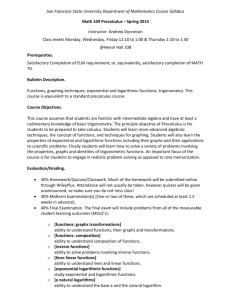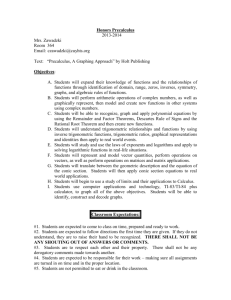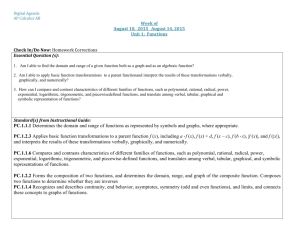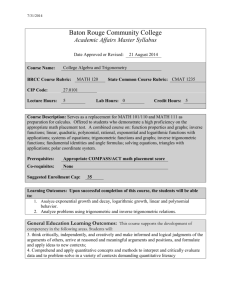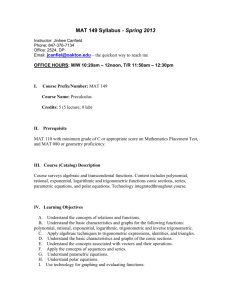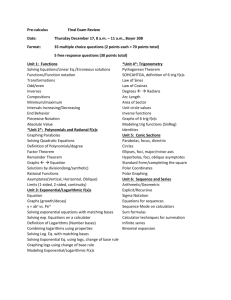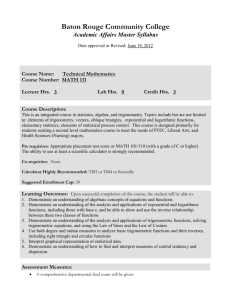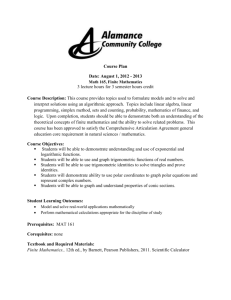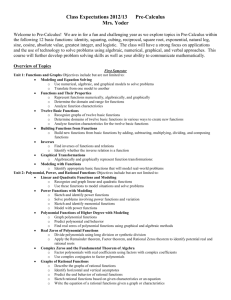Precalculus Syllabus
advertisement
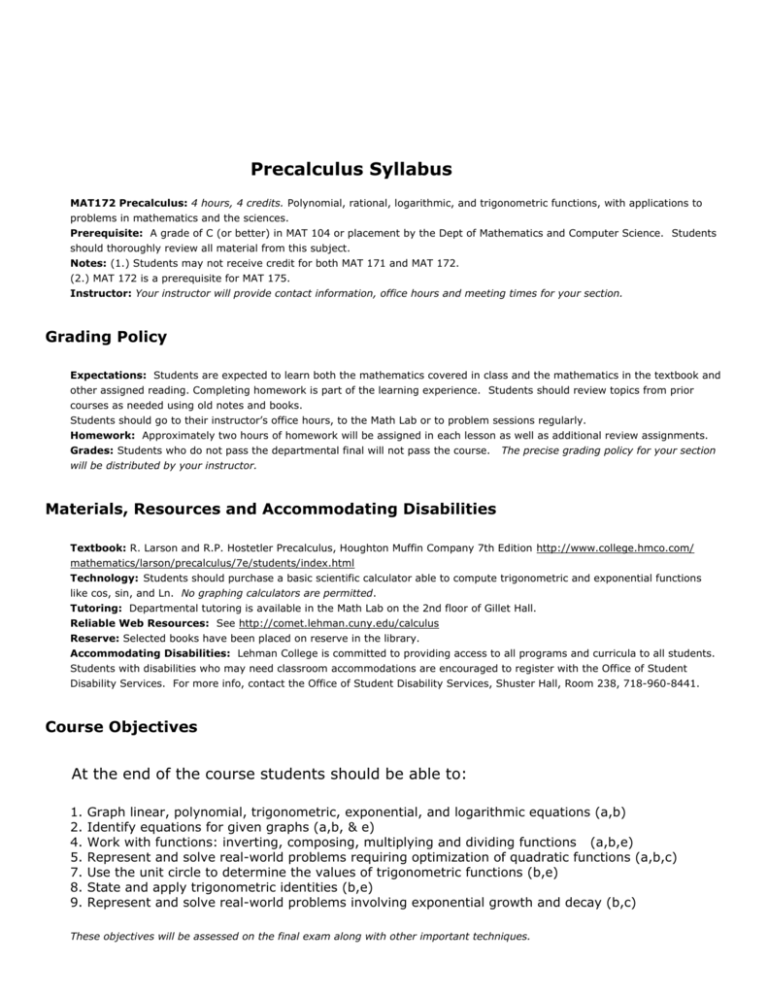
Precalculus Syllabus MAT172 Precalculus: 4 hours, 4 credits. Polynomial, rational, logarithmic, and trigonometric functions, with applications to problems in mathematics and the sciences. Prerequisite: A grade of C (or better) in MAT 104 or placement by the Dept of Mathematics and Computer Science. Students should thoroughly review all material from this subject. Notes: (1.) Students may not receive credit for both MAT 171 and MAT 172. (2.) MAT 172 is a prerequisite for MAT 175. Instructor: Your instructor will provide contact information, office hours and meeting times for your section. Grading Policy Expectations: Students are expected to learn both the mathematics covered in class and the mathematics in the textbook and other assigned reading. Completing homework is part of the learning experience. Students should review topics from prior courses as needed using old notes and books. Students should go to their instructor’s office hours, to the Math Lab or to problem sessions regularly. Homework: Approximately two hours of homework will be assigned in each lesson as well as additional review assignments. Grades: Students who do not pass the departmental final will not pass the course. The precise grading policy for your section will be distributed by your instructor. Materials, Resources and Accommodating Disabilities Textbook: R. Larson and R.P. Hostetler Precalculus, Houghton Muffin Company 7th Edition http://www.college.hmco.com/ mathematics/larson/precalculus/7e/students/index.html Technology: Students should purchase a basic scientific calculator able to compute trigonometric and exponential functions like cos, sin, and Ln. No graphing calculators are permitted. Tutoring: Departmental tutoring is available in the Math Lab on the 2nd floor of Gillet Hall. Reliable Web Resources: See http://comet.lehman.cuny.edu/calculus Reserve: Selected books have been placed on reserve in the library. Accommodating Disabilities: Lehman College is committed to providing access to all programs and curricula to all students. Students with disabilities who may need classroom accommodations are encouraged to register with the Office of Student Disability Services. For more info, contact the Office of Student Disability Services, Shuster Hall, Room 238, 718-960-8441. Course Objectives At the end of the course students should be able to: 1. 2. 4. 5. 7. 8. 9. Graph linear, polynomial, trigonometric, exponential, and logarithmic equations (a,b) Identify equations for given graphs (a,b, & e) Work with functions: inverting, composing, multiplying and dividing functions (a,b,e) Represent and solve real-world problems requiring optimization of quadratic functions (a,b,c) Use the unit circle to determine the values of trigonometric functions (b,e) State and apply trigonometric identities (b,e) Represent and solve real-world problems involving exponential growth and decay (b,c) These objectives will be assessed on the final exam along with other important techniques. Course Calendar There is flexibility in the times allotted below, but all the topics in the syllabus must be covered by the instructor and understood by the student. Students planning to take Calculus should ace this course. Lesson 1: A.3, A.5 - Review Polynomials and Factoring Online Completing the Square Worksheet Lesson 2: A.1, A.6 – Review Intervals and Inequalities Weekend Review: A.2 and A.4 check the answers to all your homework in the back of the book. Lesson 3: 1.2 - Graphs of Equations 1.3 - Linear Equations in Two Variables Lesson 4: 1.4 - Functions 1.5 Analyzing Graphs of Functions Lesson 5: 1.6 - A Library of Functions Lesson 6: l.7 - Shifting, Reflecting, and Stretching Graphs 1.8 Composition of Functions Lesson 7: Review for Exam I Lesson 8: Exam I (students who fail this exam should consider dropping the course and auditing MAT 104. Please consult with your professor or a math advisor during office hours for more personalized advising bringing a copy of your exam and completed homework) Lesson 9: 1.9 - Inverse Functions 1.10 - Mathematical Modeling Lesson 10: A.3, 2.1- Maximizing Quadratic Functions Online Examples of Maximization Online Max-Min Problem Sheet Lesson 11: 2.3 - Polynomial and Synthetic Division Review exponents A.2 Lesson 12: 3.1- Exponential Functions and Their Graphs Online Credit Card Example Lesson 13: 3.2 - Logarithmic Functions and Their Graphs 3.3 Properties of Logarithms Lesson 14: 3.4 - Exponential and Logarithmic Equations Online Inverses of Functions with Exponentials Lesson 15: Review for Exam II Lesson 16: Exam II (students who fail both exams should probably drop the course. Please consult with your professor or a math advisor for more personalized advising bringing a copy of your exam and completed homework) Lesson 17: 3.5 Exponential and Logarithmic Models Online Exponential Problem Sheet Lesson 18: 4.1- Radian and Degree Measure 4.2 - Trigonometric Functions: The Unit Circle, Pythagorean Identity Online Unit Circle Project Lesson 19: 4.3 - Right Triangle Trigonometry 4.4 - Trigonometric Functions of Any Angle Online Review of Right Triangle Trigonometry Lesson 20: Graphs of Sine and Cosine Functions 4.6 - Graphs of other trigonometric functions Lesson 21: 4.7- Inverse Trigonometric Functions 4.8 - Applications and Models Lesson 22: Review for Exam III Lesson 23: Exam III Lesson 24: 5.1 - Using Fundamental Identities 5.2 - Verifying Trigonometric Identities 5.4 - Sum and Difference Formulas and their proofs Lesson 25: 6.1 – 6.2 Law of Sines and Law of Cosines Lesson 26: 2.2 and 2.6 - Graphing Polynomial and Rational Functions Lesson 27: Catch up or 2.7 - Partial Fractions Lesson 28: Review for the Final Final Exam: A Uniform Final Exam will be given to all sections of precalculus during Finals Week covering the entire course especially topics needed in future courses. A sample final will be distributed. No calculators will be permitted on the final exam. Department of Mathematics and Computer Science, Lehman College, City University of New York

